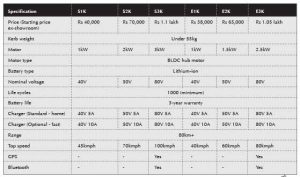Polarity Smart Bikes address range anxiety associated with EVs through Pedal-Assist System.
Story by:
Deepti Thore
Range anxiety in case of EVs is a real-world issue. It has posed a hindrance to the mass proliferation of EVs. To overcome this range anxiety, Pune based Polarity Smart Bikes registered under SJ Electric Vehicles Pvt Ltd. is banking on the Pedal-Assist Systems (PAS) which the company showcased on its ebikes at the launch earlier this year. To tap the pull for EVs created by policies and incentive campaigns built on over the last decade, the company built on the Pedal-Assist Systems to address the existing void. Positioned as India’s first Personal Mobility Vehicle (PMV), Polarity’s electric pedal-assist bikes are an interesting option for those looking at emission-free means of transportation. The pedal-assist system used in bikes is not a new concept per se. Globally known as pedelec, over the last decade, the concept of Pedal-Assist Systems has positioned itself as a viable option on the top of the ebikes classification. Pedal-assist ebikes work such that they draw power from the motor to help pedal with ease and set in motion faster than conventional bikes. It allows one to choose the level of assist desired by pedalling to get the motor to inturn supply the desired level of power output. Compared to conventional pedal-assist bikes it may require only short bursts of the pedal. The pedal assist bikes have for long drawn comparisons to the hand throttle models people are used to.
It is believed that the next decade holds even far greater potential for the evolving category. Explained Anand Mohan, Executive Director, Polarity Smart Bikes that it’s the technological innovation and low cost of electric components used in Pedal-Assist Systems that make it an attractive proposition for prospective buyers. In an effort to further classify, he added that the company is addressing two different ends of the spectrum through the ‘S’ Sports Series and the ‘E’ Executive Series. Through the ‘S’ series, the company is targeting sports enthusiasts who are fitness-oriented and ride the vehicle on-road and off-road terrains. On the other hand, the ‘E’ series is aimed at office-commuters who use public or private transport. Explaining that there are few who are utility conscious and would want to carry cargo, for this target segment, the company has provided a load-carrying utility with a rated load-carrying capacity of 50 kg in case of the executive range. Both the ebikes will be offered as single-seater variants initially when they are commercially rolled out in the first quarter (Q12020). In all, there are six models – S1K, S2K, S3K and E1K, E2K, E3K powered by 1-kW, 2-kW and 3-kW motors and a total of 36 variants that will be available when sales commence in 2020. The bike with the motor capacity of 1-kW has a maximum speed of 45 kmph In case of the 2kW, the speed is limited at 60 kmph with the top of the line 3-kW variant limited at 100 kmph. The ebikes have been further set apart from each other in terms of the overall utility levels and the support system on offer. Opined Mohan that the price band of the ebikes makes them an attractive buy. 
The cheapest variant is priced at Rs.38000 and the top of the line variant priced at Rs.1,25000 (ex-showroom). The company is especially excited about the S3K variant, the flagship model of the company, which according to Mohan guarantees thrills. It acts
either as a trail hero or a classy ride to the office. It is powered by a 3 kW BLDC hub motor which draws power from the Lithium-ion battery. The company claims a minimum of 1000 charge/discharge cycles for the battery post which one can expect the capacity to fall under 80 per cent of its original capacity. The company has placed a three-year warranty on the battery pack.
Equipped with Lithium-ion batteries, said Mohan, “These smart bikes get rid of the range anxiety often debated with speeds of up to 100 kmph and a range of 80 km on a full charge.” The pedal-assist ebikes have been deliberately designed to be light-weight and hence will be well-differentiated from other categories of electric two-wheelers existing in the market. Built on a steel frame to reduce the impact the motors and batteries experience, the major electrical components of the ebikes are packaged in a compact space to ensure higher efficiency. It is also to cut down on the wind resistance. The smart ebikes come with standard features like bluetooth connectivity and GPS tracking with the help of a proprietary mobile app. The app. is said to provide critical information like vehicle diagnostics, service logs and details, and location tracking among others. With an end goal of encouraging a healthier lifestyle, the aim is also to reduce the carbon footprint by crediting carbon points in lieu of the distance travelled through pedalling the ebikes. In addition to this, owners of the bike can look forward to boosting fitness levels by custom tweaks that include an adjustable suspension for riding on all types of surfaces. In a unique inclusion, the bike speeds can be controlled with the help of the app.
 Citing extensive research and multiple surveys of similar vehicles during the development of these bikes, Mohan expressed satisfaction at the end outcome ahead of the commercial rollout. The process entailed fault finding and going back to the drawing board in case of issues pertaining to the charging infrastructure, lack of knowledge, versatility and connectivity of the customer. Claiming to address a host of such customer pain points, the company is confident, of the pedal-assist bikes being perceived as versatile. The company is also working on introducing a two-seater version of these bikes in the near future, hinted Mohan. Pedelecs or Pedal Assist bikes can be traced to the end of the 19th century. As per the claims, in 1895, Ogden Bolton Jr., an American inventor decided to apply for the first time, an electric motor on the rear hub of a traditional bicycle. He was granted the U.S. Patent 552,271 for a battery-powered bicycle with a six-pole Brush-and-Commutator Direct Current (DC) hub motor mounted in the rear wheel. There were no gears then and the motor is known to draw 100 Amperes from a 10-volt battery pack. In 1897, Hosea W. Libbey of Boston invented an electric bicycle (U.S. Patent 596,272) that was propelled by a double electric motor. The motor was designed within the hub of the crankset axle. The model was later re-invented and imitated in the late 1990s by Giant Lafree e-bikes. By 1898 a rear-wheel drive electric bicycle, which used a driving belt along the outside edge of the wheel, was patented by Mathew J. Steffens. After many such iterations and patents registered, by 2007 e-bikes were thought to make up 10 to 20 per cent of all two-wheeled vehicles on the streets of many major Chinese cities. ACI
Citing extensive research and multiple surveys of similar vehicles during the development of these bikes, Mohan expressed satisfaction at the end outcome ahead of the commercial rollout. The process entailed fault finding and going back to the drawing board in case of issues pertaining to the charging infrastructure, lack of knowledge, versatility and connectivity of the customer. Claiming to address a host of such customer pain points, the company is confident, of the pedal-assist bikes being perceived as versatile. The company is also working on introducing a two-seater version of these bikes in the near future, hinted Mohan. Pedelecs or Pedal Assist bikes can be traced to the end of the 19th century. As per the claims, in 1895, Ogden Bolton Jr., an American inventor decided to apply for the first time, an electric motor on the rear hub of a traditional bicycle. He was granted the U.S. Patent 552,271 for a battery-powered bicycle with a six-pole Brush-and-Commutator Direct Current (DC) hub motor mounted in the rear wheel. There were no gears then and the motor is known to draw 100 Amperes from a 10-volt battery pack. In 1897, Hosea W. Libbey of Boston invented an electric bicycle (U.S. Patent 596,272) that was propelled by a double electric motor. The motor was designed within the hub of the crankset axle. The model was later re-invented and imitated in the late 1990s by Giant Lafree e-bikes. By 1898 a rear-wheel drive electric bicycle, which used a driving belt along the outside edge of the wheel, was patented by Mathew J. Steffens. After many such iterations and patents registered, by 2007 e-bikes were thought to make up 10 to 20 per cent of all two-wheeled vehicles on the streets of many major Chinese cities. ACI
Interview box : In conversation with Sachin Jadhav, Chairman and Managing Director, Polarity smart bikes.
Q: What is the potential of the pedal-assisted bike segment in India? How big is the market?
A. Currently, the pedal-assistant market is not directly categorized unlike bicycle market in India. There are plenty of bicycle manufacturers in the auto component industry but they are not legal permitters. Their numbers are really huge. Even in the motorcycle segment, the numbers are very limited but they have registration. Considering that these are two different areas, we have a certain number of bikes and we have a certain number of bicycles hence we need to categorize it first. It completely depends on the acceptance of people for such a product which is a combo of both, the bicycle and the motorcycle. We are definitely expecting to sell more than one lakh vehicle next year.
Q: A lot of the tech feature is standard on bikes today with the rising customer awareness. What do you think are the USPs of the six bikes?
A. Any pedal-assisted bike launched till date do not offer a speed more than 25 km/hour. The new vehicle with a speed of 25 km/h needs government registration. Our smart bikes have been registered and the users get the RC book, insurance, resale value, bank loan like any other motorbike. This will certainly give an advantage. Offering adjustable seat system, these bikes can be used on-road and off-road by anyone who is fond of gadget technology which enables connection with the vehicle via android and Apple IOS based system. It helps the users to track the vehicle and access it. One can also install a fitness app. and use it for health maintenance.
Q: Are these bikes well-differentiated not to affect the sales of each other?
A. I don’t think it will. The levels of customisation and levels of functionalities this bike offers, I think it’s good that people have that option. Range hoping does not happen ideally, so I am sure each bike will have its own customer base. We are showing the prototype early so that we know who wants what and what quantity. This is why we have started the pre-booking of these bikes.
Q: What is the future of EVs in the two-wheeler segment?
A. Everyone thinks the future of EVs is bright. The ICE’s are here to stay but for EVs it is in a compact space. We will definitely witness a gradual shift to electric and the EVs are going to rise.
Q: You thoughts on economic slowdown? Do you think the automobile sector will revive?
A. We have witnessed slowdown mostly in the ICE industry but they will bounce back. The economy is expected to go up and down, therefore I am positive that the sales will pick up for them. From the EV point of view, we are positive because electric vehicle sales have gone up by 130 per cent YoY for the past two years. The demand for EVs in the market have increased hence I am sure EV has a promising future.













Leave a Reply